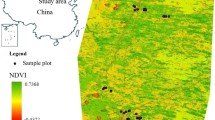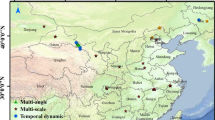Abstract
Tree growth is ordinarily affected by changes in environmental conditions, and the annual sequence of favorable and unfavorable climates is regularly recorded in wide and narrow tree rings. Therefore, data extracted from tree rings can be adopted to reconstruct the past climate. In dendroclimatology, the commonly used proxy indices to obtain paleoclimatic parameters include tree-ring width, blue intensity, density, and isotopic series. Notwithstanding, reconstructing the past local climatic parameters with high accuracy is a challenge. Here, we demonstrate how data from microscopic-hyperspectral scanning of the dendrochronological samples, together with the tree-ring width data, facilitates the precise estimation of one paleoclimatic parameter, the mean deviation of monthly air temperature. In a proof-of-concept analysis experiment, samples were collected from two sites located in the middle part of China, measured with a hyperspectral scanning system, model achieved an averaged root mean square error (RMSE) of 0.524℃ on the mean deviation of monthly air temperature from March to July, which demonstrates significant improvements in accuracy compared with the classical single-indexed tree-ring width method, especially when the number of tree-ring samples is limited. Further, our results suggest that climatic data stored in the tree-ring spectrum could be divulged by analyzing their surface hyperspectral reflectance. We hope our work will be a genesis for more intricate models in dendroclimatology that use microscopic-hyperspectral scanning as a standard tool, which promises enhanced accuracy for past climate reconstruction. Besides tree rings, the capacity of the microscopic-hyperspectral scanning technique can be exploited on other samples collected in paleoclimatology, including core samples from rocks, sediment, ice, or surface samples on shells, boreholes, and corals, to derive valuable information from their surface spectral patterns.








Similar content being viewed by others
Data availability
The datasets generated and analyzed during the current study are not publicly available due to relevant laboratory confidentiality rules.
References
Briffa KR, Jones PD, Schweingruber FH (1992) Tree-ring density reconstructions of summer temperature patterns across Western North America since 1600. J Clim 5(7):735–754. https://doi.org/10.1175/1520-0442(1992)005%3c0735:Trdros%3e2.0.Co;2
Briffa KR, Osborn TJ, Schweingruber FH (2004) Large-scale temperature inferences from tree rings: a review. Global Planet Change 40(1):11–26
Buckley BM, Hansen KG, Griffin KL, Schmiege S, Oelkers R, D’ArrigoWilson RDRJS (2018) Blue intensity from a tropical conifer’s annual rings for climate reconstruction: an ecophysiological perspective. Dendrochronologia 50:10–22. https://doi.org/10.1016/j.dendro.2018.04.003
Campbell R, McCarroll D, Loader N, Grudd H, Robertson I, Jalkanen R (2007) Blue intensity in Pinus sylvestris tree-rings: developing a new palaeoclimate proxy. Holocene 17:821–828. https://doi.org/10.1177/0959683607080523
Cook, E. R., Briffa, K., Shiyatov, S., & Mazepa, V. (1990). Tree-ring standardization and growth-trend estimation. In Methods of dendrochronology: applications in the environmental sciences (pp. 104–123).
Curran P (1980) Multispectral Remote Sensing of Vegetation Amount 4(3):315–341. https://doi.org/10.1177/030913338000400301
Donoho, D. L., & Johnstone, I. M. (1994). Threshold selection for wavelet shrinkage of noisy data. Paper presented at the Proceedings of 16th Annual International Conference of the IEEE Engineering in Medicine and Biology Society.
Duckworth J (1998) Spectroscopic qualitative analysis. In: Workman J, Springsteen AW (eds) Applied Spectroscopy. Academic Press, San Diego, pp 165–190
Fonti P, Bryukhanova MV, Myglan VS, Kirdyanov AV, Naumova OV, Vaganov EA (2013) Temperature-induced responses of xylem structure of Larix sibirica (Pinaceae) from the Russian Altay. Am J Bot 100(7):1332–1343
Fritts HC, Blasing TJ, Hayden BP, Kutzbach JE (1970) Multivariate techniques for specifying tree-growth and climate relationships and for reconstructing anomalies in paleoclimate. J app lmeteor 10(5):845–864
Fritts, H. (2012). Tree rings and climate: Elsevier.
Geladi P, MacDougall D, Martens H (1985) Linearization and scatter-correction for near-infrared reflectance spectra of meat. Appl Spectrosc 39(3):491–500
Gomez C, Lagacherie P, Coulouma G (2008) Continuum removal versus PLSR method for clay and calcium carbonate content estimation from laboratory and airborne hyperspectral measurements. Geoderma 148(2):141–148. https://doi.org/10.1016/j.geoderma.2008.09.016
Grudd H (2008) Torneträsk tree-ring width and density ad 500–2004: a test of climatic sensitivity and a new 1500-year reconstruction of north Fennoscandian summers. Clim Dyn 31(7):843–857. https://doi.org/10.1007/s00382-007-0358-2
Holmes, R. L. (1983). Computer-assisted quality control in tree-ring dating and measurement.
Isaksson T, Næs T (1988) The effect of multiplicative scatter correction (MSC) and linearity improvement in NIR spectroscopy. Appl Spectrosc 42(7):1273–1284. https://doi.org/10.1366/0003702884429869
Jesper, B. (2014). Tree-rings and climate-standardization, proxy-development, and Fennoscandian summer temperature history.
John F, Shroder J (1980) Dendrogeomorphology: review and new techniques of tree-ring dating. Sage Journals 4(2):161–188. https://doi.org/10.1177/030913338000400202
Li D, Peng Y, Zhang H (2019) Investigation on texture changes and classification between cold-fresh and freeze-thawed tan mutton. J Food Qual 2019:1–10. https://doi.org/10.1155/2019/1957486
Maleki MR, Mouazen AM, Ramon H, De Baerdemaeker J (2007) Multiplicative Scatter Correction during On-line Measurement with Near Infrared Spectroscopy. Biosys Eng 96(3):427–433
Michell AJ, Schimleck LR (1996) NIR spectroscopy of woods from Eucalyptus globulus. Appita J 49(1):23–26
Schweingruber FH, Fritts HC, Braker OU, Drew LG, Schar E (1978) The X-Ray technique as applied to dendroclimatology. Tree-Ring Bulletin 38:61–91
Schweingruber, F. H. (1996). Tree rings and environment: dendroecology: Paul Haupt AG Bern.
Sun Yu, W. L. (2013) Global research progresses in dendroclimatology of Larix Miller. PROGRESS IN GEOGRAPHY 32(12):1760–1770
Xiangding W (1990) Application of tree ring analysis in environmental change research (in Chinese). Quaternary Research 02:188–196
Xiaohua, S., Yongjin, W., Hai, C., Xinggong, K., & Jiangying, W. (2006). Stalagmite records of holocene monsoon climate evolution and drought events in Shennongjia, Hubei Chinese Science Bulletin, 051(001), 80-86
Yeh TF, Chang HM, Kadla JF (2004) Rapid prediction of solid wood lignin content using transmittance near-infrared spectroscopy. J Agric Food Chem 52(6):1435–1439. https://doi.org/10.1021/jf034874r
Zhang Z (2015) Tree-rings, a key ecological indicator of environment and climate change. Ecol Ind 51:107–116
Zhang Fangfang ZY, Guoyan P, Shuai Y, Fanxi K, Yongdong Qi, Dan W (2018) The climatic significance of δ~(18)O sequences of tree whorls in the Shennongjia area. Adv Geosci 37(07):946–953
Funding
This project is supported by the National Natural Science Foundation of China (NSFC) Project No. 42271476, the National Natural Science Foundation of China (NSFC) Project No. 41771227, and the Guangdong Science and Technology Strategic Innovation Fund (the Guangdong-Hong Kong-Macau Joint Laboratory) Project No. 2020B1212030009.
Author information
Authors and Affiliations
Contributions
Teng Fei generated the initial idea which was developed together with Meng Bian, Yadan Xu and Yonghong Zheng.
Yonghong Zheng and Haifeng Zhu provided the tree-ring samples.
Lingjun Wang and Haochen Zhang led the practical spectroscopy work, performed image analyses, and made the figures.
Teng Fei and Lingjun Wang led the writing of the paper, with all authors contributing to manuscript development.
During revising the manuscript, Bian Meng and Teng Fei provided essential ideas based on the reviewers’ comments and assisted with additional experiments. Lingjun Wang performed the main revisions. Yadan Xu and Haochen Zhang also helped with the additional experiments.
Corresponding authors
Ethics declarations
Ethics approval
The authors declare that there is no relevant ethics issue to disclose.
Competing interests
The authors declare no competing interests.
Additional information
Publisher's note
Springer Nature remains neutral with regard to jurisdictional claims in published maps and institutional affiliations.
Rights and permissions
Springer Nature or its licensor holds exclusive rights to this article under a publishing agreement with the author(s) or other rightsholder(s); author self-archiving of the accepted manuscript version of this article is solely governed by the terms of such publishing agreement and applicable law.
About this article
Cite this article
Wang, L., Fei, T., Bian, M. et al. Response of microscopical hyperspectral data to past climatic variable. Theor Appl Climatol 150, 1145–1155 (2022). https://doi.org/10.1007/s00704-022-04219-w
Received:
Accepted:
Published:
Issue Date:
DOI: https://doi.org/10.1007/s00704-022-04219-w




